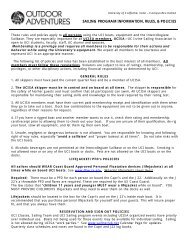J22 Manual - UCI Campus Recreation
J22 Manual - UCI Campus Recreation
J22 Manual - UCI Campus Recreation
Create successful ePaper yourself
Turn your PDF publications into a flip-book with our unique Google optimized e-Paper software.
<strong>UCI</strong> J/22 Sailing <strong>Manual</strong> 44<br />
if the halyard is long enough. Winch tight. (Be careful, mast will easily break).<br />
Lower Shroud Breaks: Tack to relieve pressure. Drop main while staying close hauled. Use<br />
topping lift as lower shroud. Winch tight. Do NOT put much strain on rig. You could sail back<br />
with jib only.<br />
Spreader Comes Loose: Push back in place and lash or use jib halyard and spinnaker pole as<br />
in "UPPER SHROUD" above.<br />
Steering Failures<br />
Two basic problems can occur with the steering gear on the J/22. The tiller can break, leaving<br />
the rudder intact but unable to be moved, or the rudder can break off partly or completely. If<br />
the tiller breaks, the boat may still be operable using the stump of the tiller and lashing the<br />
broken piece or the paddle to it with spare line. Use the sails to help you steer. (See steering<br />
with the sails below).<br />
Sailing with the Mainsail Alone<br />
This is a great option anytime you want to de-power your boat. The J/22's sail very well on just<br />
the mainsail. If the wind picks up, or you have an inexperienced crew, or you just want to sail in<br />
a more relaxed manner, take the jib down. Keep the jib sheet tight, so the jib does not blow off<br />
the deck. Use a sail-tie to hold the entire jib in place.<br />
Even though our mainsails have reef points, the best way to reduce sail area and be able to sail<br />
the boat safely in very strong winds is by lowering and furling the jib and sailing with just the<br />
reefed mainsail.<br />
Holes and Leaks<br />
About the only way a J/22 will develop a bad leak is as a result of a collision. Should this<br />
happen, lower the sails (unless they can be used to heel the boat so that the hole is out of the<br />
water). It is very difficult to plug a good-sized hole while the boat is moving.<br />
Use your flares to attract attention as soon as you have assessed the situation and determine<br />
you might need assistance. Don't wait till it is too late to use the flares. Also, put on the<br />
lifejackets.<br />
To plug the hole, use the spinnaker (if it is aboard), clothing or a cushion. If the hole is forward<br />
of the keel, the jib can be wrapped completely around the bottom of the boat, covering the<br />
hole and lashed down with a line. Water pressure will hold it over the hole. To bailout the<br />
water, use a bailer, bucket, or ice chest.







